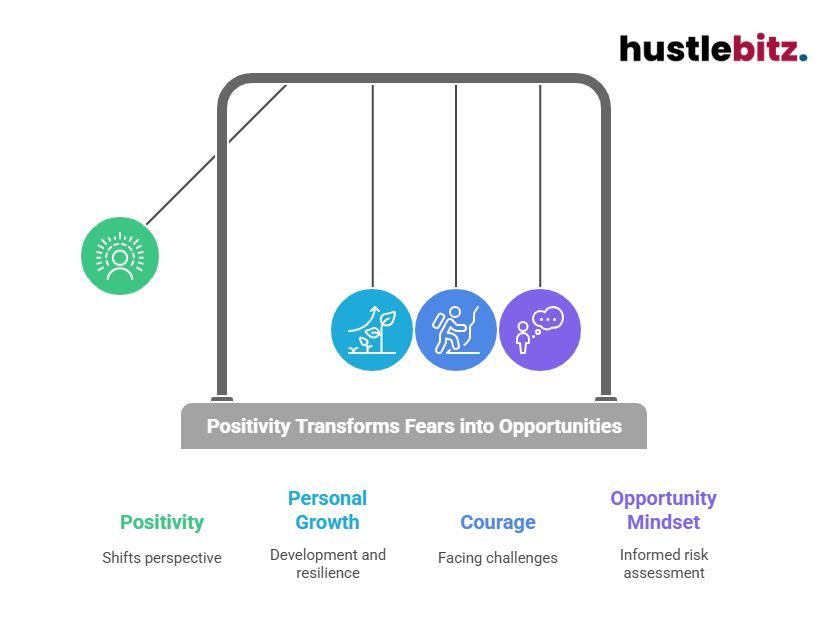Positivity serves as a powerful tool in transforming fear into opportunity. By adopting a growth mindset, individuals can reframe anxieties as chances for personal development. This shift not only builds resilience but also enhances emotional strength, encouraging proactive confrontation of fears. When failure is viewed as a learning experience, a supportive internal dialogue fosters self-belief and courage. Embracing challenges ultimately leads to informed decision-making and incremental growth. Cultivating this positive perspective can significantly empower individuals to navigate uncertainty with confidence, turning obstacles into advantageous pathways. There is much more to explore on how these principles can be applied effectively.
Key Takeaways
- Positivity shifts perspective, allowing individuals to see fears as opportunities for personal growth and development.
- Embracing failure as a learning experience fosters resilience and motivates continued efforts despite setbacks.
- A supportive internal dialogue nurtures emotional strength, turning anxiety into courage for facing challenges.
- Incremental exposure to fears builds coping mechanisms, reinforcing the ability to navigate uncertainty with confidence.
- Viewing challenges as stepping stones cultivates an opportunity mindset, promoting informed risk assessment and growth.

Positivity Against Fear

In the face of fear, cultivating a mindset rooted in positivity can serve as a powerful antidote, transforming anxiety into actionable opportunities for growth and resilience. Fear management is essential for individuals seeking to navigate life’s challenges, and developing a positive mindset is a cornerstone of this endeavor.
By embracing optimism, individuals can reframe their perspectives on fear, viewing it not as an insurmountable barrier but as a catalyst for overcoming obstacles. This shift in mindset fosters emotional strength, enabling individuals to confront their fears with courage and determination.
When fear is approached with positivity, it encourages self-belief, allowing individuals to recognize their inherent capabilities. This self-awareness is crucial in the journey of personal development, as it empowers individuals to tackle challenges head-on rather than succumbing to paralysis by fear.
Moreover, a positive mindset promotes resilience, providing the tools necessary to bounce back from setbacks. It creates a supportive internal dialogue, reminding individuals that failure is often a stepping stone to success.
By focusing on growth rather than defeat, those grappling with fear can transform their experiences into lessons that fortify their resolve. Ultimately, the interplay between positivity and fear management cultivates a robust foundation for overcoming obstacles.
Turning Fear Into Opportunity
Transforming fear into opportunity requires a deliberate shift in perspective that encourages individuals to recognize the potential for growth inherent in their anxieties. This process begins with effective fear management, where individuals confront their fears through fear exposure, thereby diminishing the power these fears hold over them. By facing fears directly, one can assess risks more accurately, allowing for informed decision-making that aligns with personal and professional goals.
Cultivating an opportunity mindset is crucial in this transformation. This mindset empowers individuals to view challenges as stepping stones rather than obstacles, fostering resilience and adaptability. It encourages the exploration of new possibilities, turning apprehension into actionable insights.
Courage building is an essential component of this journey; it involves taking incremental steps toward confronting fears, thereby reinforcing one’s ability to cope with uncertainty.
Moreover, risk assessment plays a pivotal role in transforming fear into opportunity. By evaluating potential outcomes and weighing the benefits against possible drawbacks, individuals can make calculated decisions that propel them forward. This analytical approach not only mitigates paralyzing anxiety but also illuminates the paths available for growth and advancement.
Shifting Perspectives for Growth

A shift in perspective can significantly enhance personal and professional growth by enabling individuals to reinterpret challenges as opportunities for development. This process, often referred to as perspective transformation, allows individuals to adopt a growth mindset, where they view setbacks not as failures but as stepping stones toward success.
Cognitive reframing plays a crucial role in this transformation. By consciously changing how we perceive and respond to challenges, we can foster resilience and creativity. Self-awareness practices, such as mindfulness and reflection, further aid in identifying limiting beliefs, encouraging openness to new viewpoints.
To illustrate the impact of shifting perspectives, consider the following table:
| Mindset Shift | Outcome |
| Viewing failure as defeat | Feeling discouraged and stuck |
| Viewing failure as learning | Gaining insights and motivation |
| Blaming external factors | Developing a victim mentality |
| Taking personal responsibility | Empowering self and fostering growth |
Cultivating Resilience in Adversity

Cultivating resilience in adversity enables individuals to navigate challenges with greater strength and adaptability, ultimately leading to personal growth and improved well-being. Resilience building is a vital skill that empowers people to face challenges head-on and develop an adaptive mindset. This mindset allows individuals to view obstacles not as insurmountable barriers but as opportunities for learning and development.
Emotional strength plays a crucial role in resilience. By fostering emotional awareness and regulation, individuals can better manage their reactions to stressors. This process of self-reflection and emotional intelligence equips them with the tools necessary to confront difficulties with confidence. When faced with adversity, those who practice resilience building are more likely to maintain a positive outlook, which can significantly influence their ability to recover and thrive.
Moreover, overcoming obstacles is often a gradual process that requires patience and persistence. Cultivating resilience involves embracing setbacks as part of the journey, recognizing that growth often occurs outside one’s comfort zone. Individuals who understand this are better positioned to embrace challenges, utilizing their emotional strength as a foundation for progress.
Embracing Change With Confidence
Embracing change with confidence is essential for personal and professional growth, as it allows individuals to navigate uncertainty and seize new opportunities. In an ever-evolving landscape, embracing uncertainty becomes a vital skill. Those who adopt an adaptive mindset can effectively manage the challenges that change presents, transforming potential fears into avenues for development.
Confident transitions are rooted in self-awareness and the recognition that change is a natural part of life. By understanding their strengths and weaknesses, individuals can approach new situations with a sense of assurance. This confidence not only fosters resilience but also encourages a proactive stance, wherein welcoming challenges becomes a catalyst for innovation and creativity.
A positive outlook is crucial when facing change. Individuals who maintain optimism are more likely to view obstacles as opportunities rather than threats. This perspective is instrumental in overcoming initial resistance to change, allowing for a smoother transition. By re-framing challenges as chances to learn and grow, individuals cultivate a mindset that embraces rather than fears uncertainty.
Ultimately, embracing change with confidence empowers individuals to take calculated risks and explore uncharted territories. This transformative approach not only enhances personal satisfaction but also contributes to professional advancement. In a world where change is the only constant, those who navigate with confidence will find themselves better equipped to thrive amidst the complexities of life.
Final Thoughts
Transforming fear into opportunity requires a deliberate shift in mindset that fosters resilience and emotional strength. By embracing positivity, individuals can reframe anxieties and challenges as pathways for growth. Techniques such as cognitive reframing, cultivating an opportunity mindset, and engaging in courage building empower individuals to overcome obstacles with confidence. Embracing failure as a learning experience and maintaining a positive internal dialogue helps navigate uncertainties, allowing for informed decision-making and incremental progress. With these strategies, individuals can rise above fear and turn adversity into advantageous opportunities for personal and professional growth.




